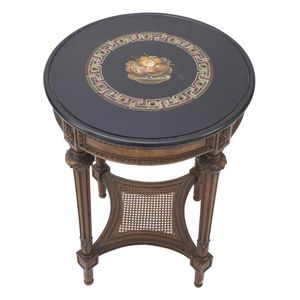Italian Micromosaic Table on Louis XVI Style Walnut Frame
A fine Italian micromosaic table top mounted on a Louis XVI style walnut frame, the top mid-19th century, the base late 19th century, the circular black marble top inlaid to the centre with a micromosaic still life of fruit in a glass bowl within an architectural key pattern border, 75 cm high overall, the top 56 cm diameter
You must be a subscriber, and be logged in to view price and dealer details.
Subscribe Now to view actual auction price for this item
When you subscribe, you have the option of setting the currency in which to display prices to $Au, $US, $NZ or Stg.
This item has been sold, and the description, image and price are for reference purposes only.
- Greek Key Pattern - The Greek key pattern is a decorative design that consists of continuous interlocking vertical and right-angled lines that form a repeating motif. It is also known as "Meander" or "Greek fret." The pattern is thought to have originated in ancient Greece, where it was used in various decorative arts, such as pottery, metalwork, and architectural elements. The Greek key design is widely used in a variety of contexts, including classical architecture, decorative arts, furniture, interior design and textiles. The pattern is considered timeless and classic, and its geometric simplicity makes it a popular choice for designers in many different fields.
- Inlay - Decorative patterns inserted into the main body of a piece of furniture, generally in wood of contrasting colour and grain, though brass, ivory, ebony, shell and sometimes horn have been used. Inlay may consist of a panel of well figured timber inset into a cabinet door front, geometric patterns, or complex and stylized designs of flowers, swags of foliage, fruits and other motifs. As a general rule, in pieces where the carcase is constructed in the solid, the inlay is relatively simple such as stringing, cross banding and herringbone banding. Where more elaborate and decorative work was required veneer was used. Inlay has been fashionable from at least the latter half of the 17th century, when a variety of elaborate forms were developed
This item has been included into following indexes:
